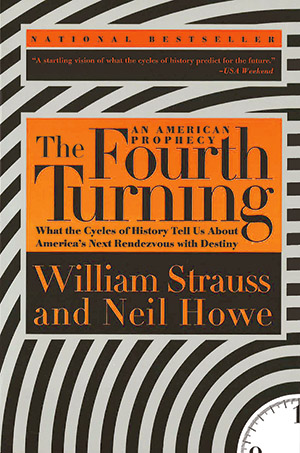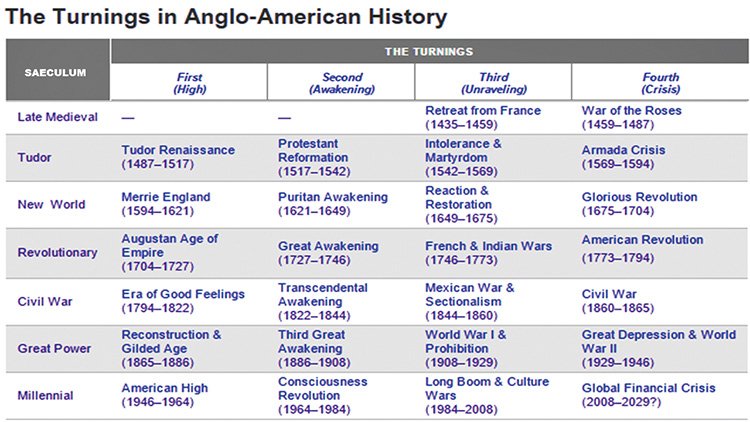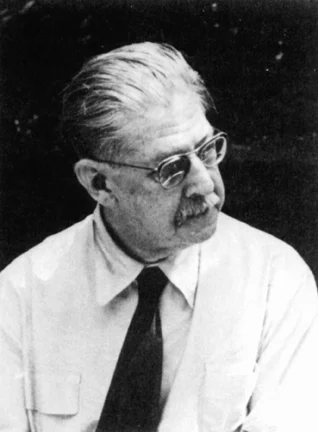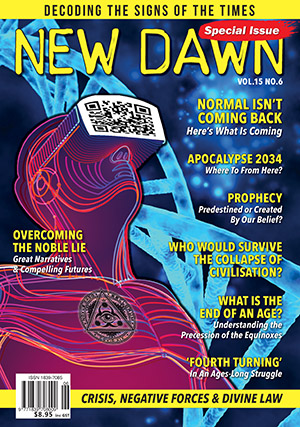From New Dawn Special Issue Vol 15 No 6 (Dec 2021)
The remarkable 1997 book The Fourth Turning: An American Prophecy by William Strauss and Neil Howe argues that the familiar linear approach to history taught in most western education and academia is a fairly recent paradigm containing dangerous flaws. They argue, instead, that seeing history in terms of recurring cycles provides insights that modern linearity obscures – “one year’s (or one saeculum’s) winter is more like the prior winter than like the autumn that came right before it,” they explain.1
The authors state that by perceiving these cycles, we can perhaps become more aware of impending change. On the contrary, linear or straight-line thinking often causes its adherents to be completely blindsided. Using American history as an example, they point out that as late as December 1773, the idea that the American Revolution would begin in the near future seemed nearly impossible. The same can be said about November 1859 regarding the impending start of the American Civil War that broke out in 1861. Or early October 1929 when virtually nobody expected the sudden end to the Roaring Twenties caused by a catastrophic crash of the stock market that started on October 24 (“Black Thursday”), accelerating from October 29 (“Black Tuesday”).2
Building upon their observation of generational cycles occurring every four generations going back through history for millennia, Strauss and Howe predicted that the current mood of pessimism and disillusionment is typical of a specific point in the cycle. This inevitably precipitates a major crisis which the authors, writing in 1997, predicted would arrive sometime between 2005 and 2025:
Around the year 2005, a sudden spark will catalyse a Crisis mood. Remnants of the old social order will disintegrate. Political and economic trust will implode. Real hardship will beset the land, with severe distress that could involve questions of class, race, nation, and empire. Yet this time of trouble will bring seeds of social rebirth. Americans will share a regret about recent mistakes – and a resolute new consensus about what to do. The very survival of the nation will feel at stake. Sometime before the year 2025, America will pass through a great gate in history, commensurate with the American Revolution, Civil War, and twin emergencies of the Great Depression and World War II.3
In 2011, I wrote an essay regarding these pronouncements of Strauss and Howe, in the process of my reflecting on the tenth anniversary of September 11, 2001. At that time, I said:
It is clear that many of these predictions are coming true, particularly the prediction that “political and economic trust will implode.” It would appear, however, that so far, no “great Crisis” as momentous as the Revolution or the Second World War has yet been sparked. The two authors’ warnings that those living in 1929 or 1859 or 1773 did not see the impending Crisis of their age should give us cause for concern that such a Crisis may yet be around the corner, and cause to pay attention to the cycles that the authors outline in their book.4
Almost exactly ten years later, it certainly feels as though the Crisis that Strauss and Howe predicted has either arrived or very much “around the corner.” The way we choose to act over the coming months and years will be critical for our future and that of generations to come.
Descent into Linearity
Whether you agree with all the conclusions and predictions in The Fourth Turning, one of the most noteworthy features of the book is the authors’ demonstration that the peculiar modern faith in linear progress is a historical anomaly. They find evidence that “nearly all non-Western cultures accept the periodic regularity of time” – meaning by “periodic regularity” the view that time operates in cycles, with a kind of circular rhythm, in contrast to the view that time is linear, which is a relatively modern development in their analysis.5
Strauss and Howe argue that this modern linear view of time is a product of the Enlightenment that dominated the eighteenth century, during which this approach grew into “a complementary secular faith… – the belief in indefinite scientific, economic, and political improvement.”6 They posit that this faith in linear progress reached its height at the end of the nineteenth century, and that it has always been strongest in America where a widespread belief developed that mankind had finally broken away from “any risk of cyclical regress.”7
Strauss and Howe state:
Triumphal linearism has shaped the very style of Western and (especially) American civilisation. Before, when cyclical time reigned, people valued patience, ritual, the relatedness of parts to the whole, and the healing power of time-within-nature. Today, we value haste, iconoclasm, the disintegration of the whole into parts, and the power of time-outside-nature.8
These are broad generalisations, and any book of this nature will test the reader’s patience with such sweeping categorisations, but these overviews do appear to capture some truths worth considering.
Interestingly, this very belief in unbroken linear progress that has gripped western thought since the Enlightenment is reinforced by the dogmas of Darwinism and modern official teachings on our ancient history. It theorises that we have supposedly evolved in a generally unbroken upward line from the “ape-like progenitors” Darwin describes in Descent of Man9 all the way to modern humans, who then progressed from early hunter-gatherers to pastoral herders living a nomadic life, to basic planters and harvesters capable of organising simple villages, and who then made it in a linear fashion to create increasingly complex civilisations.
Although virtually all academia today still enforces some version of the above linear paradigm of humanity’s ancient history, the evidence overwhelmingly suggests this view of the ancient past cannot possibly be correct. Instead, compelling evidence supports the conclusion that humanity was highly advanced in the distant past (long before ancient Greece and Rome) and, for some reason, fell into relative ignorance for millennia thereafter – a very nonlinear view of ancient history.
Cycling Back to the Ancient World
Archaeological evidence around the world points to advanced capabilities which even today we barely understand, including the quarrying and transportation of massive blocks weighing over a hundred tons at sites such as Pumapunku in South America, the Osirion in Egypt, or blocks weighing well over a thousand tons at Baalbek in modern-day Lebanon, and the remarkable level of precision displayed on certain ancient artefacts (including on some of the massive blocks at Pumapunku).
Author Christopher Dunn, a professional engineer and craftsman with extensive experience in the aerospace industry, compiled an overwhelming amount of evidence demonstrating beyond any possible dispute that archaeological artefacts found throughout Egypt and available for detailed examination today exhibit evidence of advanced precision machining. These could not have been manufactured any other way, certainly not with hand tools such as the chisels and pounding-stones on display in many museums, right next to the amazing artwork supposedly produced with such crude implements.
He explores several examples in his groundbreaking 2010 book, Lost Technologies of Ancient Egypt: Advanced Engineering in the Temples of the Pharaohs, establishing beyond doubt that artefacts in Egypt display manufacturing precision built on a knowledge base which was later completely lost for thousands of years. Modern engineers would, in many cases, have a difficult time duplicating these artefacts today (in fact, they could not have done this with tools available just fifty years ago, before advances of recent decades).
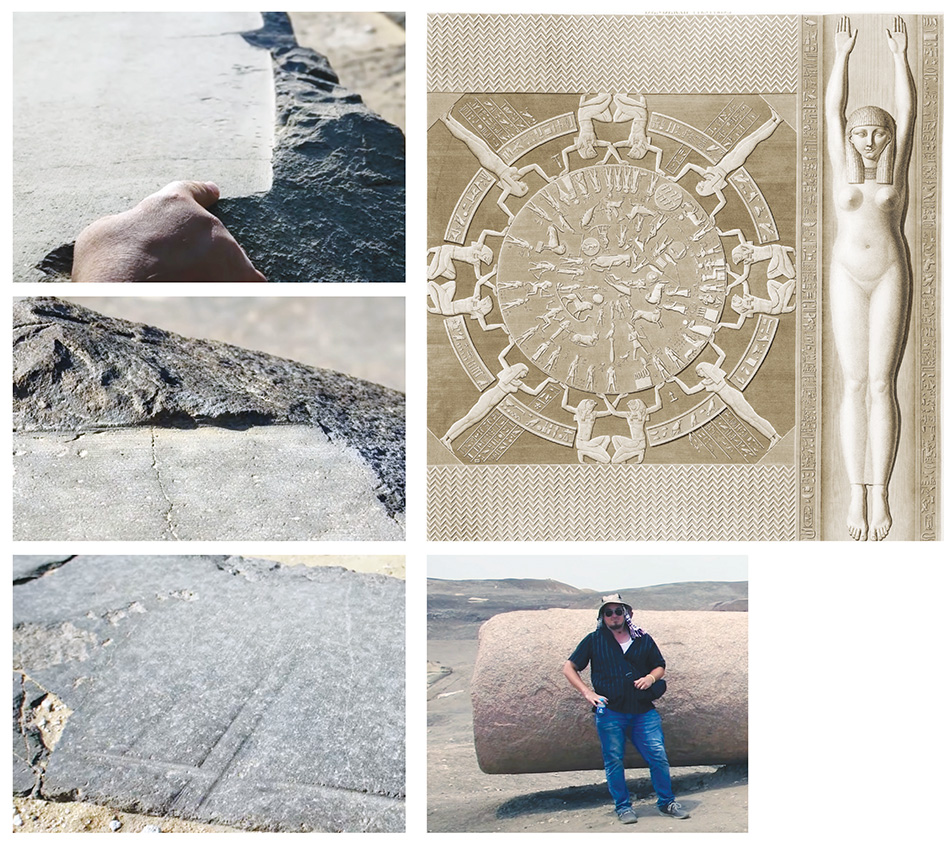
Building on the work of Christopher Dunn, and in some instances travelling to Egypt with him, as well as travelling on his own to other ancient sites around the globe, researcher and documentary film-maker Ben Van Kerkwyk of UnchartedX has filmed hundreds of hours of footage allowing viewers of his videos to see with their own eyes these ancient artefacts and ancient tool-marks. Dunn and Van Kerkwyk’s research demonstrates undeniable evidence of advanced technologies, suggesting that sophisticated civilisation existed before dynastic Egypt, capable of producing artwork and objects that even the ancient Egyptians could not duplicate.
The interested reader (or the sceptic who still doubts the existence of advanced technologies that upend the conventional timeline of human history taught in academia) is strongly encouraged to visit Ben’s website at www.unchartedx.com and his associated YouTube channel. Watch two or three of his videos and see the evidence which speaks for itself. The most compelling proof involves ‘mistakes’ where marks and cuts on ancient artefacts reveal that the person operating a cutting tool made an error. Judging by the cuts that can be seen today, the tool continued its incision further than would have been the case with simple hand tools. These ‘mistakes’ show that some kind of high-powered equipment was employed that carried on with the cut before the operator stopped it.
Our Shared Body of Myth
In addition to the physical archaeological evidence scattered around the globe, which we can still examine today, there is another amazing body of evidence in the world’s surviving myths, from cultures on every inhabited continent and island of our earth. As I have been documenting for over a decade, this body of myth can be shown to be based on a common system of celestial metaphor and closely related in a way that explodes the conventional paradigm of humanity’s ancient history.
The very existence of a worldwide system of this nature, in which specific mythical characters are associated with specific constellations – and in which certain characteristics accompany constellations and the mythical figures associated with those constellations across mythologies in cultures separated by enormous distances and by vast oceans – cannot be explained within the timeline of history promoted by conventional academia.
How can we explain obvious parallels in sacred stories preserved among the cultures of the Americas as well as in well-known myths of ancient Greece, for example, or between biblical stories and the myths of the cultures of the Pacific Islands, the civilisations of ancient Mesopotamia, the Ko-Ji-Ki of early Japan, and the Sanskrit epics of ancient India?
These connections suggest the existence of some predecessor culture (or cultures), now completely ignored or denied by today’s official paradigm, prior to the most ancient civilisations known to academia. This system of celestial metaphor in myth was already fully developed in the earliest surviving texts of ancient Egypt, ancient India, and ancient Mesopotamia.
Even beyond those connections, which cannot be explained using the conventional paradigm of human history, the myths of cultures around the world preserve evidence of an extremely sophisticated understanding of celestial mechanics, including an understanding of the rate of precession (whose mythological importance is discussed in my accompanying article on page 51).
Conventional history holds that precession (a very subtle celestial phenomenon, and one that requires many years and even centuries of careful observation and record-keeping and analysis to even detect) was not discovered until the time of the Greek astronomer Hipparchus (190–120 BCE). The rate of precession of one degree every approximately 72 years was not even known when Ptolemy wrote his Almagest in the second century CE. Yet, the precessional number 72 and its multiples (including 108, 216, and 432) appear over and over in ancient myths and sacred stories around the world – and in contexts which can be shown to metaphorically relate to the observable effects that precession has on the constellations of the night sky!
The myths, in other words, demonstrate that precession was understood in the distant past, long before it was ‘discovered’ (actually re-discovered) by Hipparchus. Far from a linear progression, humanity realised enormous levels of understanding and achievement in very ancient times (more ancient than any civilisation known to conventional history), only to lose that knowledge for thousands of years. The evidence indicates we have yet to come close to regaining those levels of understanding and ability – a shocking proposition for the adherents of the linear model of human progress!
Although this evidence (both mythical and archaeological) is easy to examine, abundant, and very difficult to dispute, conventional academia has – in remarkable lockstep – roundly rejected anyone arguing that the current paradigm is gravely flawed and in need of radical revision. Instead, they have continued to cling to the dogmas of linear progress. In my 2011 article exploring The Fourth Turning and the tenacity of the linear dogma, I wrote:
It is quite likely that the faith in linearity that Strauss and Howe detail in their book has blinded scholars and others to the possibility of an ancient advanced civilisation and created a bias towards the acceptance of Darwinian biological theories, which in turn lead to linear anthropological theories as well.10
Re-visiting the question after ten more years of work, and after the discovery of much more evidence showing beyond doubt the existence of a worldwide system of metaphor operating at the foundation of the world’s ancient myths, I am less inclined to take such a charitable view in describing the ongoing propagation of historical paradigms that cannot possibly be true, and which are roundly refuted by overwhelming evidence.
Indeed, there is now plenty of evidence that the truth of our ancient history has been actively suppressed as part of a conspiracy reaching back thousands of years to empower some at the expense of the vast majority of humanity. Keeping this history secret makes it easier to keep us divided and from the ancient wisdom preserved in the myths.
Cyclical Time & Patterns
Interestingly enough, in The Fourth Turning, Strauss and Howe note that ignorance of the cyclical nature of time, or even massive attempts to deny these cycles and live as though cycles do not exist, does not free us from the cyclical nature of time at all. On the contrary, their findings suggest that cultures embracing cyclical time are less buffeted by the waves of the changing cycles, while cultures ignoring cycles exacerbate their effects so that they experience even greater volatility – all the more painful because it is unexpected (unlike the cycles experienced by cultures that expect and respect the cyclical nature of time).
The analysis of Alsatian scholar R.A. Schwaller de Lubicz uncovered numerous cyclical patterns and harmonies between generations living hundreds or even thousands of years apart (at similar distances from precessional turning points). He points this out in his books such as Sacred Science:
Since the Middle Ages, our Occident [the West] has been blinded, particularly by the cerebration of the Greek Eleatics who preferred reasoning to experimentation. The beginning of this disquieting period of “arguers” can be situated with the Eleatic school around 550 or 500 BC, a school founded at about the same time as the Pythagorean order, of mystico-religious character. Those five centuries before the precessional passage from Aries to Pisces stand in curious correspondence with our sixteenth century, also five centuries before the next precessional passage from Pisces to Aquarius: Toward the year 1500, with the Renaissance, ancient Greece was again raised to honour in the West.11
Later in the same book he writes:
Their [the Stoics’] champion was Zeno of Citium, who lived from 362 to 260 BC, which is about two hundred years before the precessional transition from the vernal point of the sign of Aries to that of Pisces. In the Stoic pursuit of freedom, we find a curious similarity to the ideal of the revolutionaries of 1789, a revolution which was also situated about two centuries before the new precessional transition of the vernal point from the sign of Pisces to that of Aquarius. This brings to mind a similar great revolution which took place at the end of the Old Empire of the Pharaohs, about 2400 BC, two centuries before the passage of the vernal point of the sign of Taurus into that of Aries.12
In light of these and other apparent harmonies, de Lubicz declared, “The history of the world is strangely cyclical.”13
Facing the next ‘Crisis’
While Strauss and Howe seem to indict the European Enlightenment for starting the modern dogmatic cult of unbroken linear progress, it should be noted that the Enlightenment was at its core a virulent rejection of the stifling institutions of feudalism dominating Europe throughout the Middle Ages. It was an attempt to free Europe, intellectually and economically, from those ongoing feudal patterns – patterns that grew directly out of the destruction of the ancient ways by the proponents of literalist Christianity, by whom the Roman Empire was taken over and then broken apart, ushering in centuries of brutal oligarchy supported by the teachings of the Church.
As I have demonstrated in my examination of the stories of the Bible totalling many hundreds of pages, overwhelming evidence proves that those stories are based on the same system of ancient metaphor that formed the foundations for the myths and stories of other cultures around the world. Literalistic interpretations of the Bible are mistaken and only leads to misinterpretation of the scriptures. Thus, the rejection of lingering remnants of feudalism – and oppressive literalistic religious dogmas abetting feudal oppression – appears to have led to a (perhaps understandable) mistake when this rejection of the literalist Church and its flawed teachings offered in its place the ‘secular faith’ described by Strauss and Howe, with uncritical belief in unending and inevitable “scientific, economic, and political improvement.”
As American economist Michael Hudson, author of numerous books and essays including the newly-revised third edition of his original 1972 book Super Imperialism – now subtitled in this current edition The Economic Strategy of the American Empire – has explained at length, the oligarchical beneficiaries of the feudalist system did not passively accept the philosophical, political, and economic attacks on the structures of oligarchy launched during the eighteenth century and which gained ground throughout most of the nineteenth: they struck back quite forcefully and managed to erect numerous powerful neo-feudal structures to preserve their exploitative racket.

geopolitical tensions across the globe and further societal division in the United States.
I suggest that the Crisis predicted by Strauss and Howe, which may now be unfolding before our very eyes, along with virtually all other “Crisis” examples offered by these authors (including the American and French Revolutions, the American Civil War, the Great Depression and Second World War), can best be understood in light of this centuries-old struggle against the proponents of feudalism (and, in the modern era, neo-feudalism – complete, it seems, with draconian restrictions on movement and travel reminiscent of the condition of serfs in Medieval Europe).
Feudalism can be seen to be the system established by those opponents of the ancient wisdom preserved in the myths – myths testifying (along with overwhelming archaeological evidence) to the cyclical nature of the human story, and to the existence of a now-forgotten predecessor culture (or cultures) whose very existence is vehemently denied by academia and by the proponents of the modern ‘science’ cult and unending linear ‘progress’.
We find ourselves in the midst of one battle in a very, very old war.
Footnotes
1. William Strauss and Neil Howe, The Fourth Turning: An American Prophecy, Crown, 1997, 21
2. Ibid., 5-6
3.Ibid., 6
4. David Warner Mathisen, “The Fourth Turning and cyclical time and history,” Mathisen Corollary blog, 11 September, 2011
5. Fourth Turning, 32
6. Ibid., 9
7. Ibid., 10
8. Ibid.
9. Charles Darwin, The Descent of Man and Selection in Relation to Sex, Volume One of Two Volumes, Appleton, 1871, 94, 133
10. Mathisen, “The Fourth Turning and cyclical time and history.”
11. R. A. Schwaller de Lubicz, Sacred Science: The King of Pharaonic Theocracy, Inner Traditions, 1982, 18
12. Ibid., 43
13. Ibid., 30
© New Dawn Magazine and the respective author.
For our reproduction notice, click here.



